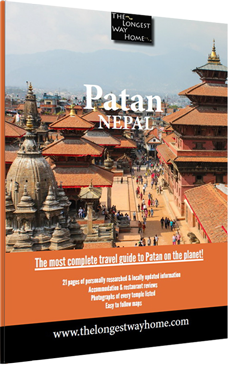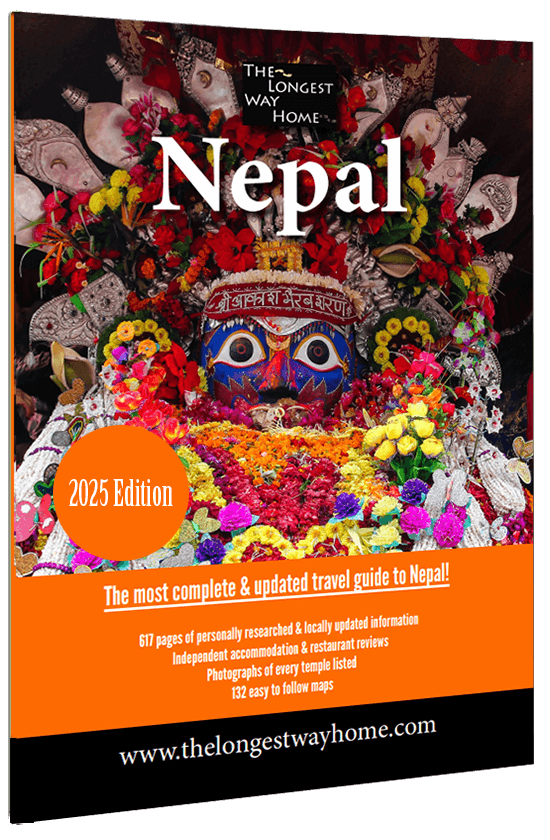About the Rato Machhendranath temple
Located in to the south of Patan Durbar Square the Rato Machhendranath temple (Matsyendra / Macchindranāth / Machchendranath) is also known as Temple of Bunga: Dyaa. It's construction was completed in the 16th century and it is one of the oldest Matsyendra temples in Nepal. It is dedicated to both the Buddhist and Hindu saint Matsyendra and also recognized as a rain god of the same name.

A man and a temple of many names. Locally, the Rato Machhendranath temple is known to Newars (local population) as Bunga: Dyaa or simply as the Machhendranath temple. Rato means red, and indeed, the statue of Machhendranath inside is red. However, there is another famous Machhendranath temple in Kathmandu which has a white statue and is known as the Seto Machhendranath temple. They are both dedicated to the same Machhendranath, and the only difference in the naming comes from the color.
A historic Tibetan manuscript tells of a man who fled the Turkish and Afghan invasions in North India around 1000 AD.
Bungmati, over 2,500 years old, seven kilometers south of Patan, is named after a prehistoric god of rain. Machhendranath is said to have arrived in Kathmandu as a Hindu-Buddhist monk who had a very strong following. The two have been linked ever since.
It's easy to walk by the entrance way to this temple. Watch out for the whitewashed gateway!
Did you know?
The temple courtyards precious artifacts all have iron fences to prevent any theft.
There's usually a caretaker inside or around the temple itself along with local residents whose houses surround the area.
History of the Machhendranath temple
At one time Gorakhnath (a yogi trained by Machhendranath) tricked nine chief Naags into a well. The naags are serpents that bring rain to the valleys. Thus a drought shortly followed.
The king asked Machhendranath for help. By now Machhendranath was reincarnated into a small boy who’s mother would not let him go. With persuasion Machhendranath moved into a bee and was placed into a water container. When Machhendranath reached the well Gorakhnath rose up from the well to greet his teacher.
As he did so the naags escaped and the drought ended. Machhendranath agreed to stay in the valley for half a year in this temple.

It is believed Machhendranath was born in Bungamati in the Kathmandu Valley so for six months every year the Rato Machhendranath statue stays in Bungamati while for the other six month the statue stays in the Rato Machhendranath temple.
It's also important to note that Machhendranath is linked with the Hindu cult the Natha. They believed in both Hinduism and in part Buddhism. Machhendranath and his followers are said to have visited many holy sites in Nepal including the Stupa at Swayambu where there's an inscription of him. Interestingly these years are followed by a "dark" period in Nepali history when little or no history was recorded. It's during this period that Swayambhu (Singru-vihara-caitya-bhatjarika) or Swayambhu Maha Chaitya became known as Swayambhunath and likewise in Boudhanath. The changing of these names is lost in history but the evidence suggests that Machhendranath (900CE) and his follower Gorakhnath may well have had some influence in their naming. What is clear is that throughout Nepal Machhendranath is one of the most revered figures that continues on today.
Part of the respect given to Machhendranath occurs every year in Nepal during the Rato Machhendranath festival.
Rato Machhendranath Festival
The Rato Machhendranath festival occurs every year at the start of spring using a lunar calendar (May / April). This festival largely takes place throughout Patan as the Rato Machhendranath statue is transported to different locations in a tall wooden chariot. The festival is to celebrate the rain god Rato Machhendranath in the hope of good seasonal crops.

All in all the Rato Machhendranath festival takes place over several weeks. The main parts of the festival include the Rato Machhendranath statue getting bathed in honey and milk at Ta baha which is located behind the main Machhendranath temple.
The chariot which has been constructed at Pul Chowk is make entirely from wood and ropes. The only part with metal are the wheels. It's certainly worthwhile to visit the chariot during its construction as it's quite a spectacle.
Rato Machhendranath is then moved to the chariot and over a period of over week is transported to various sites in Patan including Gabahal, Sundhara, Lagankhel and ends at Jawalakhel. It should be noted that these locations change, randomly every year. In part due to municipality planning permission, in part due to road construction and in part due to festival priests changing the areas. At one period the Chariot visit all three cities, Patan, Bhaktapur and Patan.
At the end of the procession the statue is taken to Bungamati ( birthplace of Machhendranath) where it resides for the next six months. In the past there were often injuries during the festival from people falling off the chariot to being crushed by crowds. Injuries still happen but crowd control has helped.
Of note there is another famous Machhendranath festival which is called Seto Machhendranath (white Machhendranath) which takes place in Kathmandu slightly before the Rato Machhendranath, again for the welcoming of spring and again with a similar chariot that visits locations around Kathmandu city. The Seto Machhendranath statue resides in Jana Bahal in Kathmandu.
Inside the Rato Machhendranath temple courtyard
One of the highlights of the temple are its intricate roof carvings that depict tortured people in a form of hell. Many say this is to show that the god can rescue people from such a fate.

While not going inside the temple, you can get an excellent view of Machhendranath himself from the steps outside. One of the few temples in the valley that affords you the privilege.
The outer courtyard is surrounded by a blue fence which is locked at night to prevent theft. Inside the courtyard, you will also notice unusual iron cages surrounding many of the artifacts. Primitive protection they might be. But, they do the job!
To the rear of the temple is Ta Bahal, a monastery used to bathe the Rato Machhendranath statue every year.
Renovation on the temple

The small Ta bahal (monastery) to the rear of the Machhendranath temple was renovated in 2016. The Machhendranath temple itself was largely undamaged in the 2015 earthquake. However, small maintenance does occur here on occasion, though rarely will it affect a visit.
Entrance fee for the Rato Machhendranath temple
There is currently no entrance fee to visit the temple or its compound. During the day, the Rato Machhendranath temple square is quite empty, so there is no overcrowding here.
Map of Rato Machhendranath temple & Patan
Use this map of Patan for to locate the Machhendranath temple and other highlights in Patan. For a better map download my full travel guide to Patan
Machhendranath temple is located at the end of a main street in south Patan.
Exit Durbar Square and take a right at Ticchu Galli. Continue to the end of the street and take a left. Walk about 500 feet until you see the whitewashed gate arch to the temple on your left. See my guide below for detailed directions.
Download my guidebooks to Nepal
Liked this page? You'll love my books! They are hands on guidebooks that are better than the rest. Yes, really! In them I cover all attractions with step-by-step accuracy using well researched information, photographs and travel tested walking tours.
It's an interactive & printable guidebook like no other.
 |
 |
Was this page helpful to you? If so please tell others!


